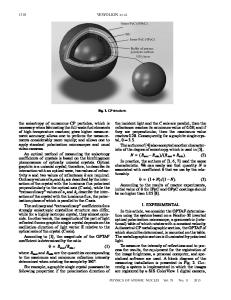Preparation of Carbon Molecular Sieves by Pyrolytic Carbon Deposition
- PDF / 124,837 Bytes
- 5 Pages / 595 x 842 pts (A4) Page_size
- 89 Downloads / 332 Views
Preparation of Carbon Molecular Sieves by Pyrolytic Carbon Deposition ´ ´ CARLOTA GOMEZ DE SALAZAR, ANTONIO SEPULVEDA-ESCRIBANO AND FRANCISCO RODR´IGUEZ-REINOSO∗ Departamento de Qu´ımica Inorg´anica, Universidad de Alicante, Apartado 99, E-03080 Alicante, Spain [email protected]
Abstract. The effect of different preparation parameters (pyrolysis temperature, process time, benzene concentration and residence time) on the properties of carbon molecular sieves obtained by pyrolytic carbon deposition from benzene on a microporous activated carbon, has been studied. For a fixed process time of 2 h, the increase of the pyrolysis temperature from 525 to 700◦ C produced a strong increase of the CO2 /CH4 selectivity, reaching a maximum value of 13 for pyrolysis at 700◦ C. Selectivity also increased with process time (up to 5 h, with the pyrolysis temperature fixed at 650 and 675◦ C), yielding values as high as 28. The obtained results have allowed to find the optimal preparation parameters for the preparation of CMS with high selectivity. Keywords: carbon molecular sieves, carbon deposition, adsorption, separation
1.
Introduction
Carbon molecular sieves (CMS) are carbonaceous materials characterized by a very narrow micropore size distribution, which produces high adsorption selectivity. These materials are receiving increasing attention because of their practical interest in fields such as catalysis and separation of gas mixtures, where they show some advantages over zeolites (greater thermal stability in non oxidizing atmospheres, higher chemical stability and larger adsorbate packing density in their slitshaped micropores). A great variety of methods have been used for the preparation of CMS’s: thermal and chemical activation of chars (De Salazar et al., 2000; Hu and Vansant, 1995), deposition of pyrolytic carbon (Cabrera et al., 1993), controlled oxidation of chars (G´omez-de-Salazar et al., 2000), etc. This contribution presents the results obtained in a study on the effect of different preparation parameters on the properties of carbon molecular sieves produced from peach stones by a carbonization-thermal activation process followed by deposition of pyrolytic carbon. The pyrolytic carbon or pyrocarbon is generally obtained from the thermal de∗ To
whom correspondence should be addressed.
composition of volatile unsaturated hydrocarbons such as benzene (used in this piece of work), propylene, isobutylene, etc. (Becker and H¨uttinger, 1998). The process is not simple, given that both homogeneous and heterogeneous reactions can be involved. In this way, the control of experimental variables is of pristine importance to achieve good reproducibility and controlled pyrocarbon deposition, this yielding CMS with the desired properties. 2.
Material and Methods
The starting material was an activated carbon obtained from peach stones. The raw material was ground and sieved to obtain particles in the range 2.0–2.8 mm, treated with a diluted sulfuric acid solution and thoroughly washed with distilled water. It was carbonized unde
Data Loading...











